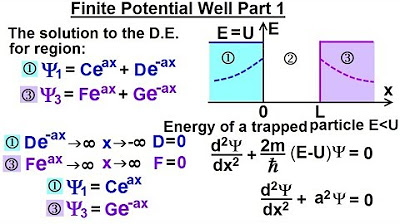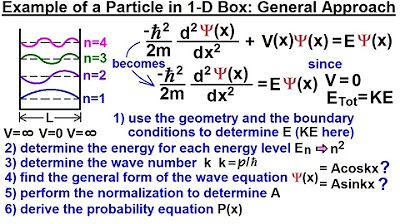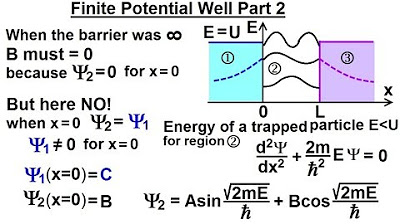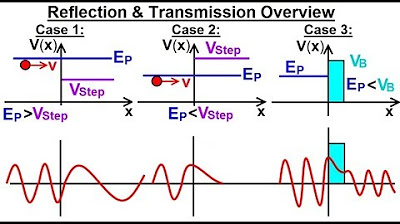Physics - Ch 66 Ch 4 Quantum Mechanics: Schrodinger Eqn (36 of 92) Finite Potential Well Part 5
TLDRThis script delves into the behavior of particles within finite wells, contrasting it with those in infinite wells. It explains how the solutions to the Schrödinger equation differ inside the barriers and in the well, highlighting the presence of decay functions and the role of energy levels. The discussion includes the impact on wavelength and momentum, noting that particles in finite wells have slightly longer wavelengths and lower momenta than those in infinite wells of the same width. The script outlines the conditions for the functions' values and slopes to match at boundaries, leading to specific energy levels and penetration depths within finite wells.
Takeaways
- 🌟 In a finite well, the solutions to the Schrodinger equation exhibit probability within the barriers, indicating the presence of the particle outside the well's boundaries.
- 📈 The wave functions in regions one and three feature decay functions, while region two (inside the well) has sine and cosine components, depending on the energy level.
- 🔢 Quantum numbers determine the different energy levels (subscripts n, m, etc.) and the corresponding waveforms of the particle within the well.
- 🌀 As energy increases, the particle exhibits an increasing number of wavelengths, with energy defined by the formula n^2 * π^2 * Hbar^2 / (2m * L^2), where L is the well's length.
- 🔗 Boundary conditions require that the function values and their derivatives match at x=0 and x=L, ensuring continuity across the well and barriers.
- 🛑 The actual wavelength in a finite well is slightly larger than in an infinite well of the same width, affecting the energy levels and momentum.
- 🌊 For the first energy level, the well length equals half a wavelength, but in a finite well, this half-wavelength is slightly longer than the well's length.
- 🚀 The momentum of a particle in a finite well is smaller than in an infinite well at the same energy level due to the longer wavelengths.
- 📌 Specific values for energy levels (e_sub_n) and penetration depth can be calculated based on the particle's mass and energy.
- 📋 Understanding these constraints allows for the precise definition of wave functions inside and outside the well, and the determination of finite well characteristics.
Q & A
What is the main difference in the solutions to the Schrodinger equation for a finite well compared to an infinite well?
-In a finite well, there is a probability that the particle will be found within the barrier regions, which is not the case in an infinite well where the probability is zero within the barriers.
How does the wave function behave in region one and region three of a finite well?
-In region one and region three, the wave function exhibits a decay function to the left and right, respectively, indicating the probability of the particle's presence in these regions.
What are the key components of the wave function in region two of a finite well?
-In region two, the wave function has both a sine and a cosine component, which are related to the energy levels and the quantum number of the particle.
How does the energy of a particle in a finite well relate to the quantum number and the dimensions of the well?
-The energy of a particle is given by the formula E_n = (n^2 * π^2 * Hbar^2) / (2m * L^2), where n is the quantum number, m is the mass of the particle, L is the length of the well, and Hbar is the reduced Planck constant.
What is required for the wave functions to match at the boundary of the well?
-At the boundary, the value of the function and its slope must be equal on both sides of the boundary. This ensures continuity and physical relevance of the solutions.
How does the wavelength of a particle in a finite well compare to that in an infinite well?
-The actual wavelength in a finite well is slightly larger than it would be in an infinite well of the same width. This is because in a finite well, the particle's wave function extends slightly beyond the boundary.
What is the relationship between the wavelength and the momentum of a particle in a finite well?
-The momentum of a particle is inversely proportional to the wavelength (p = H / λ). Since the wavelength in a finite well is slightly larger than in an infinite well for the same energy level, the momentum in a finite well is slightly smaller.
What are the constraints on the energy levels in a finite well?
-The energy levels in a finite well are quantized and depend on the quantum number, the mass of the particle, and the dimensions of the well. These constraints ensure that only specific values of energy can exist.
How does the penetration depth in a finite well depend on the mass and energy of the particle?
-The penetration depth is influenced by the mass of the particle and its energy level. The specific values for the penetration depth are determined by the solutions to the Schrodinger equation that satisfy the boundary conditions.
What is the significance of the boundary conditions in solving the Schrodinger equation for a finite well?
-The boundary conditions are crucial for finding the exact solutions to the Schrodinger equation. They ensure that the wave functions and their slopes are continuous at the boundaries, which is necessary for physically meaningful solutions.
How does the concept of finite and infinite wells relate to the understanding of quantum confinement?
-Finite and infinite wells are fundamental models in quantum mechanics that help in understanding quantum confinement effects. In a finite well, the confinement leads to quantized energy levels and modified wave functions compared to the infinite well, where the confinement is complete and the energy levels are also quantized but without wave function penetration outside the well.
Outlines
🌟 Introduction to Finite Wells and Quantum States
This paragraph introduces the concept of finite quantum wells and their implications on particle behavior. It explains the difference in the Schrödinger equation solutions within the barriers of finite wells, highlighting the probability of particle existence in these regions. The discussion also touches on the decay functions in regions one and three, and the sine and cosine components of the equation in region two, where the particle's energy is above the absolute zero floor level. The role of quantum numbers and energy levels in determining the particle's waveform within the well is emphasized, as well as the relationship between energy, wavelength, and the well's length. The paragraph concludes with the necessity of matching function values and slopes at the boundaries for the equations to align correctly.
Mindmap
Keywords
💡Finite Wells
💡Schrodinger Equation
💡Probability
💡Wave Function
💡Energy Levels
💡Quantum Number
💡Boundary Conditions
💡Wavelength
💡Momentum
💡Potential Energy
💡Fenestration Depth
Highlights
Finite wells and particles exhibit solutions to the Schrodinger equation that differ inside the barriers.
There is a probability for a particle to be found inside the barriers, which will be discussed later.
The solution for region one shows a decay function to the left, and region three shows a decay function to the right.
In region two, where the particle's energy is above the absolute floor zero energy level, the equation includes a sine and cosine portion.
Different energy levels are associated with different wave forms for the particle within the well, determined by quantum numbers.
The energy of the particle is defined as n^2 * π^2 * H_bar^2 / (2m * L^2), with L being the length of the well.
For the equations to match, the function values and slopes at x=0 and x=L must be equal.
The actual wavelength inside a finite well is slightly larger than in an infinite well of the same width.
In a finite well, the particle extends slightly beyond the boundary, requiring a longer wavelength for the functions to align.
The momentum of a particle in a finite well is smaller than in an infinite well for the same energy level due to the longer wavelength.
The specific values for energy levels (e_sub_n) and penetration depth depend on the mass and energy of the particle.
Strict rules can be defined to find the exact equations that match inside and outside the well, and to determine the fenestration depth.
Understanding these constraints is key to working with potential finite wells.
The decay functions in regions one and three are crucial for understanding the behavior of particles within finite wells.
The sine and cosine components in region two are indicative of the particle's wave-like behavior within the well.
Matching function values and slopes at the boundaries is essential for solving the Schrodinger equation for finite wells.
The wavelength and momentum differences between finite and infinite wells of the same width are significant for quantum mechanics.
Transcripts
Browse More Related Video

Physics - Ch 66 Ch 4 Quantum Mechanics: Schrodinger Eqn (17 of 92) How to Use Schrod. Eqn: 2

Physics - Ch 66 Ch 4 Quantum Mechanics: Schrodinger Eqn (32 of 92) Finite Potential Well Part 1

Physics - Ch 66 Ch 4 Quantum Mechanics: Schrodinger Eqn (18 of 92) Particle in 1-D Box: Gen. Appr.

Physics - Ch 66 Ch 4 Quantum Mechanics: Schrodinger Eqn (33 of 92) Finite Potential Well Part 2

Lecture 11: Dispersion of the Gaussian and the Finite Well

Physics - Ch 66 Ch 4 Quantum Mechanics: Schrodinger Eqn (61 of 92) Reflection & Transmission
5.0 / 5 (0 votes)
Thanks for rating: